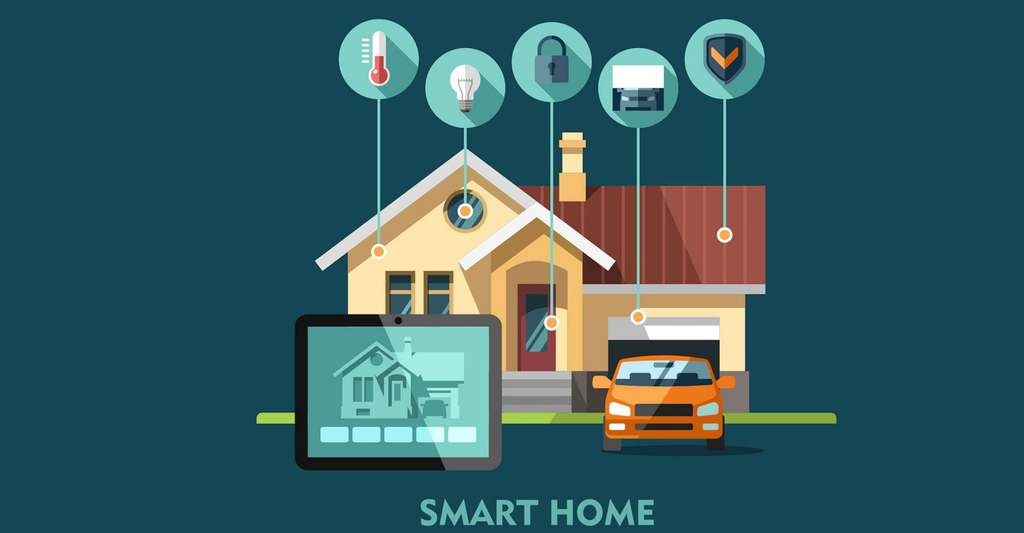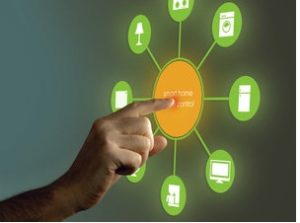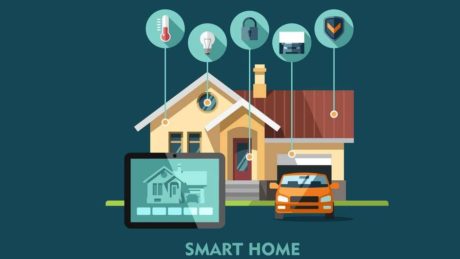You can now turn your home to Smart Homes. It’s easy!
Smart Home and Home Automation Systems

Are you desirous to know what home automation is and how it can turn your home to be a Smart Home and make it more comfortable and liveable? If so, you are in good company!
Each year, more and more people are discovering that home automation systems, far from being the purview of only the most tech-savvy folks out there, have a little something to offer everyone.
“Smart Home” is the term commonly used to define a residence that has appliances, lighting, heating, air conditioning, TVs, computers, entertainment audio & video systems, security, and camera systems that are capable of communicating with one another and can be centrally controlled remotely by a time schedule, from anywhere.
Home automation on the other hand more accurately describes homes in which nearly everything — lights, appliances, electrical outlets, heating and cooling systems — are hooked up to a remotely controllable network.
Put simply, “home automation describes a system of networked, controllable devices that work together to make your home more comfortable, customized, efficient, and secure. You “speak” with your automated home through a remote control or smart device. Homes that have a high degree of automation often have all of their automated devices accessible on one device, making it truly easy to control your home with the touch of a button.”
The range of controls that you have over your automated devices depending on the purpose of the device you want to have. Some controls allow you to turn a device on or off at a specific time, while other devices may be triggered by some external events.

You probably live with a number of automated devices in your home already: automated devices include thermostats and other heating and cooling devices, alarm systems, lights, blinds and shades, and even audio systems! While a truly automated home might have all of the above (and more), the good news for today’s consumer is that you have the ability to pick and choose the aspects of home automation that are for you.
In the past, automation was something that only commercial buildings and the highest-end homes could truly take advantage of. Whatever your needs and preferences, now is an exciting time to be involved with the home automation field. However, advances in technology and an increased demand for these technologies scaled for the home mean that, finally, home automation is within reach for those consumers who wish to create a truly smart, intuitive home.
Once upon a time, home automation devices were both pricey and hard to use. Today’s high end brands have invested much in the user experience, because they know that today’s savvy consumer isn’t interested in a product that makes them work to be able to use it. That’s good news all around. Here, we dive a little deeper into home automation, with an eye towards helping you decide whether home automation is right for you.
What can be automated?
Picture this: you’ve just arrived at work. Suddenly, you begin to feel that old, familiar, anxious pull. Something’s amiss. Did you leave the stove or air conditioner on? Is the door unlocked? Is the dog roaming free in the house rather than locked up safe in her kennel?! If your home isn’t automated, you may feel that you have no other options but to pack up and go home to turn off the oven/lock the door/lock up Muffin.
But, an automated house has your back. From the convenience of your smart phone or tablet, you have the ability to investigate and rectify all of the above scenarios. Check the status of common kitchen appliances, lock and unlock the doors, even peer in on the pets (or your children!) via surveillance camera to make sure thing everything is copacetic at home.

In addition to making it easier in the event that you have a memory slip, home automation can simply make your home run better. Take, for example, automated thermostats. There are several popular and well-respected products on the market today that allow you to control the temperature of your home remotely. If no one is going to be home, you set the temperature high. Coming home at 6:00? An automated thermostat will allow you to tell the AC to switch on at 5:30 so that by the time everyone arrives, the house is cold and comfortable. In fact, today, there are some automated thermostats that are so smart, they can even begin to learn your habits and predict what you’ll want in the absence of specific directives from you!
From kitchen gadgets, to security lighting, music and cameras, to blinds and window shades, there is truly something for everyone out there. The trick is to look before you leap, however – while there are better products on the market than ever before, not everybody needs everything that can be automated. Before taking the plunge and automating a specific aspect of your home, make sure you understand the cost and benefits of automating that particular device.
What are the benefits of an automated home?

The benefits of home automation are many. The first and often most persuasive benefit of home automation is the convenience factor. There is just nothing like being able to communicate with your home remotely, from wherever you are. A smart home is truly the next level in convenience and customization. However, not to be glossed over are some of the ancillary benefits of home automation. These include:
Safety and Security
A smart home is one that anticipates your needs, even when you aren’t there. We have already talked about devices that turn your AC on when you need it, but now let’s take a moment to talk about something that goes beyond simple creature comforts. The security of your home is probably one of the most important things about it. Home automation can make a secure home even more secure. Let’s say, for example, that you have houseguests for the weekend. Wanting them to have the freedom to come and go, you provide them with a key for the duration of their stay.
While those house guests wouldn’t be likely to use the key for nefarious reasons, what if they mistakenly forget the key? Rekeying your locks is expensive, but not doing so could put the safety of your home at risk. An automated locking system can do away with all of that worry and expense. Instead of handing out physical keys, keyless entry systems on your home allow you to provide guests to your home with a code. Once they no longer need access to your home, you can simply delete the code. This is just one example among many of how home automation can increase the security of your home.
Efficiency
In addition to enhancing home security, home automation can make your home run more efficiently. With more and more homeowners looking for ways to green their homes, it’s no wonder that automated devices have come to fill that niche. Automated window treatments are a wonderful example of home automation that delivers on a variety of levels. Not only are motorized blinds far more convenient than manually changing the position of all of the blinds in your home each and every day, but they can help your home run much more efficiently. How?
Consider this: In an effort to reduce energy bills, you turn the air conditioning off during the summer when nobody is home. You might have a few warm hours after your return home while you wait for the house to cool down again, but then you realize that your windows have actually been working against you all this time. When your shades or blinds stay in the same position all day long, they let the sun in to heat up your space. While this is a plus in the cold seasons, it is a definite negative in the hot seasons, when you have to drop the temperature down that extra seven degrees. Instead of allowing Mother Nature to heat things up in there, schedule your blinds to raise and shut in time with the sun. In the hot seasons, shades down at the peak of the day and in the cold, shades up when you need all the help you can get.
***
Are you intrigued? Hopefully home automation is something that you are interested in learning even more about! If you like research, you’ll find that you are in good company – there is a wealth of information out there that exists for you to explore and the more informed you are, the better suited you’ll be to choose the automated solutions that work for you!
Contact us today for a solution tailored to your needs and more so affordable.
- Published in Newsletter
SecuriFire 3000
SECURIFIRE – 3000, 2000, 500
SecuriFire is an advanced automatic fire alarm system for detecting the outbreak of a fire without the need for human detection; it warns any persons at risk, and mobilises the fire-fighting forces. The system consists of the fire alarm control panel, fire detectors of many kinds, manual call points, sirens, bacons, flash lights, power supply, the alarm unit and the connecting cable lines.
SecuriFire is also a fire extinguishing control panel, so you so not need to buy an external panel any longer, Thanks to the hardware redundancy for both components and line.
We provide a full line of advanced, intelligent and addressable fire alarm control panels with expandable modular components.
Our products are as well suited as the areas of application are varied: fire detectors, smoke detectors, sensitive detectors, alarm systems, etc., combine to create efficient monitoring systems.
SecuriFire – the benefits:
lightning-fast detection of incipient fires
Fully compatible fire alarm control panels for all system sizes
Maximum reliability and full redundancy for optimal security
up to 16 ring circuits with 3,500 elements per control unit
Modular, decentral design
Networking for small-scale systems up to large-area networked comprehensive systems
Well organized and easily understandable display and operation in the language of the country
data interfaces to the outside and to higher level systems
also certified extinguishing panel
simple planning, programming and operation
highest security standards
Simple, structured configuration with PC software
Tested and approved in compliance with current standards and directives (e.g. EN 54, VdS)
SecuriFire fire alarm system is modular in design; all types of system configuration are conceivable. Both centralized and decentralized systems (and combinations thereof) can be implemented, depending on needs and requirements. However, our participating loop devices and point detectors use specialized protocol that can only be implemented on our SecuriLine.
- Published in Newsletter



